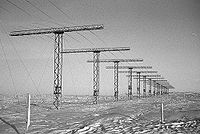
Southern Hemisphere Auroral Radar Experiment
Encyclopedia

Ionosphere
The ionosphere is a part of the upper atmosphere, comprising portions of the mesosphere, thermosphere and exosphere, distinguished because it is ionized by solar radiation. It plays an important part in atmospheric electricity and forms the inner edge of the magnetosphere...
and magnetosphere
Magnetosphere
A magnetosphere is formed when a stream of charged particles, such as the solar wind, interacts with and is deflected by the intrinsic magnetic field of a planet or similar body. Earth is surrounded by a magnetosphere, as are the other planets with intrinsic magnetic fields: Mercury, Jupiter,...
. SHARE is operated jointly by the University of Natal
University of Natal
The University of Natal was a university in Natal, and later KwaZulu-Natal in South Africa, that is now part of the University of KwaZulu-Natal. It was founded in 1910 as the Natal University College in Pietermaritzburg, and expanded to include a campus in Durban in 1931. In 1947, the university...
, Potchefstroom University, the British Antarctic Survey
British Antarctic Survey
The British Antarctic Survey is the United Kingdom's national Antarctic operation and has an active role in Antarctic affairs. BAS is part of the Natural Environment Research Council and has over 400 staff. It operates five research stations, two ships and five aircraft in and around Antarctica....
and Johns Hopkins University
Johns Hopkins University
The Johns Hopkins University, commonly referred to as Johns Hopkins, JHU, or simply Hopkins, is a private research university based in Baltimore, Maryland, United States...
and operates out of British Halley Station
Halley Research Station
Halley Research Station, run by the British Antarctic Survey, is located on the Brunt Ice Shelf floating on the Weddell Sea in Antarctica. It is a British research facility dedicated to the study of the Earth's atmosphere...
, South African SANAE IV
SANAE IV
SANAE IV is the current research base of the South African National Antarctic Expedition and is part of the South African National Antarctic Program...
Station and Japanese Showa Station.
Using a total of 16 antennas, each mounted on a 12 m tower and radiating on fixed frequencies in the 8 MHz - 20 MHz range, SHARE transmits an RF pulse into the upper atmosphere every two minutes. The three stations' ranges overlap to cover most of the Antarctic continent.
SHARE is part of the international Super Dual Auroral Radar Network
Super Dual Auroral Radar Network
The Super Dual Auroral Radar Network is an international radar network for studying the upper atmosphere and ionosphere, comprising eleven radars in the northern hemisphere and seven in the southern hemisphere that operate in the High Frequency bands between 8 and 22 MHz...
(SuperDARN). It supplies valuable data to track space weather
Space weather
Space weather is the concept of changing environmental conditions in near-Earth space or thespace from the Sun's atmosphere to the Earth's atmosphere. It is distinct from the concept ofweather within the Earth's planetary atmosphere...
.
See also
- High Frequency Active Auroral Research Program (HAARP)High Frequency Active Auroral Research ProgramThe High Frequency Active Auroral Research Program is an ionospheric research program jointly funded by the U.S. Air Force, the U.S. Navy, the University of Alaska, and the Defense Advanced Research Projects Agency ....

